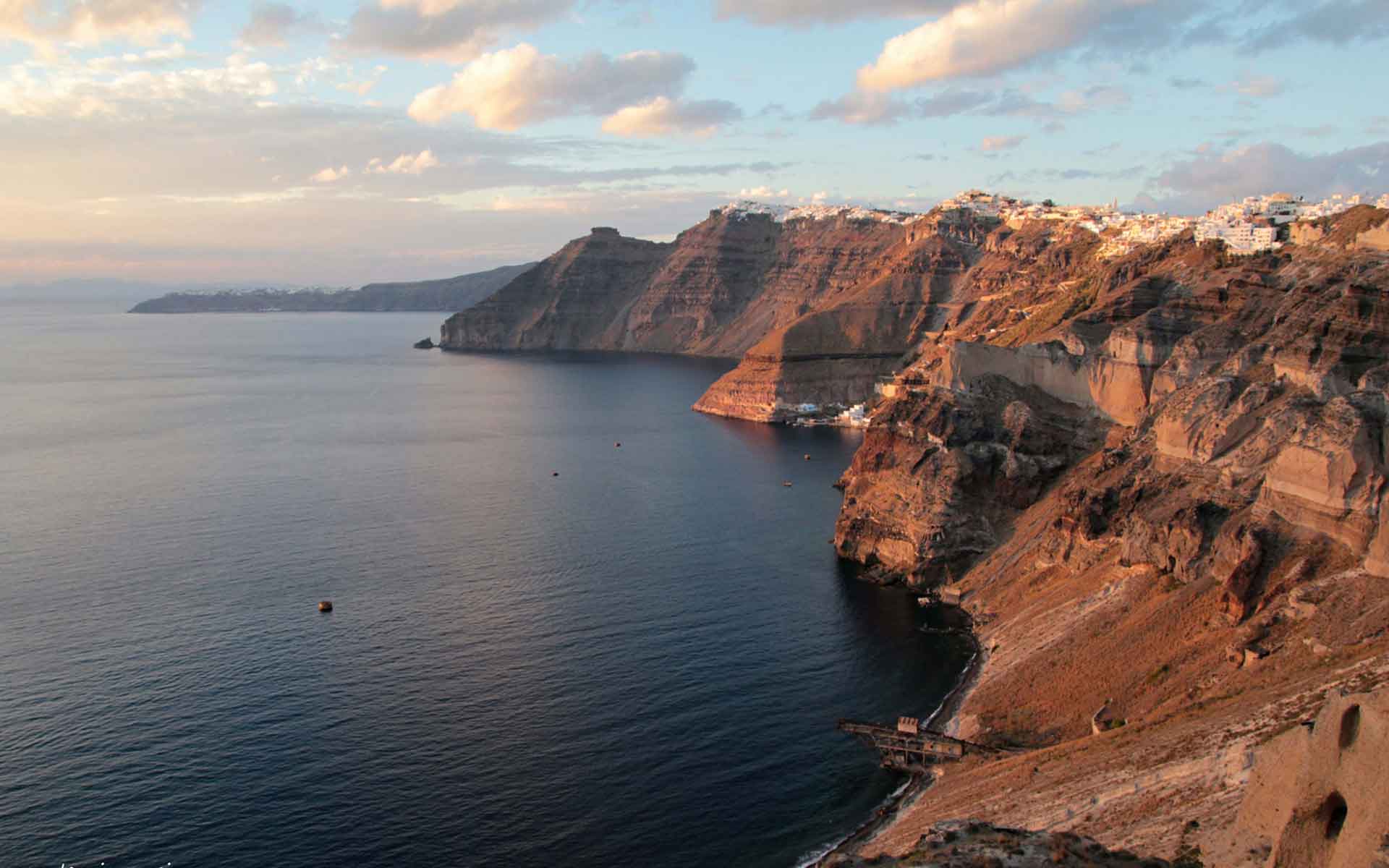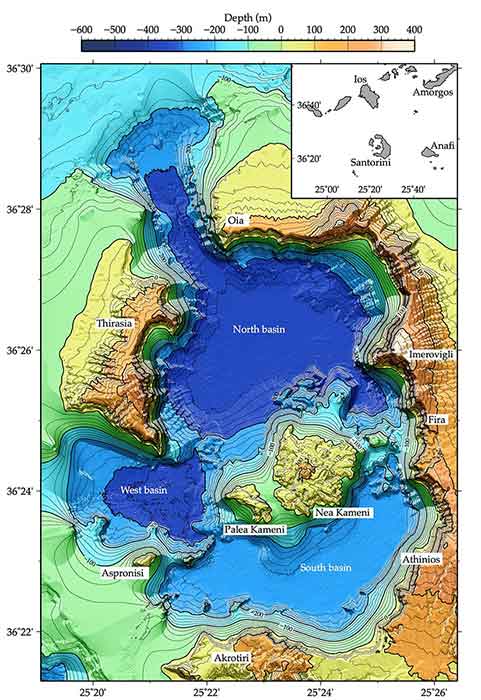
Dafni crater on Nea Kameni and view of the cliffs of caldera. (Photo: A. Argyrou).
Geological Period
Middle Pleistocene – Holocene
Main geological interest
Volcanology
Location
Thira Island, Region of South Aegean, Cyclades, Greece.
36°24’38.0″N, 25°23’33.0″E
Dafni crater on Nea Kameni and view of the cliffs of caldera. (Photo: A. Argyrou).
One of the largest Calderas in the Mediterranean Sea formed by Plinian eruptions in a volcanic arc tectonic framework.
The caldera is the result of one of the most destructive and the most famous of the eruptions that have impacted ancient civilizations, the iconic Minoan Eruption which occurred approximately 3600 years before present. This eruption may has contributed to the fall of the Great Minoan Civilization, leaving its imprint on Greek mythology (Atlantis), archaeology and volcanology in general (McCoy F. and Heiken G., 2000; Nomikou et al., 2016). It is also outstanding that the stratigraphy of the volcanic rocks of multiple eruptive episodes is evident in the caldera walls. The entire area of the caldera features outstanding geological and natural characteristics, thus making it a living laboratory for earth sciences, volcanic risk monitoring and study (Pyle and Elliott, 2006).
- Geological description
With dimensions of 8 x 11 km, it is one of the largest calderas globally, a result of many Plinian eruptions that have occurred from different eruptive centers during the volcanic history of the region (650-0 Ky) (Druitt, Francaviglia, 1992). Its steep and imposing walls portray layers of explosive products including lavas and pumice, intercalated by paleosols that represent a cease of activity. Unique volcanic landforms, including lava tubes and veins that fill tectonic structures, offer a glimpse of the interior of past volcanic centers and can be found on many areas along the caldera walls. Santorini is part of a broader volcanic field that has been active for more than half a million years, and offers a perfect natural laboratory for studying arc volcanism. It has undergone twelve powerful Plinian eruptions over the past 350.000 years, at least four of which caused a caldera collapse (Druitt, 2014). These voluminous eruptions are fed by reassembling magma chambers located at approximately 4-8 km depth, which are refilled with magma from a deeper sub-caldera reservoir (McVey et al., 2020). Plinian eruptions are estimated to occur every 10 – 30 thousand years and are separated by Sub – Plinian periods, which are characterized by effusion of lavas that build shields, accompanied by weaker explosive activity.
- Scientific research and tradition
Existing onland volcanological research, sea floor mapping, shallow coring and dredge sampling, combined with a dense network of seismic profiles, a 3D marine-land active-source seismic dataset and the pioneering IODP Ocean Drilling (Exp 398) make Santorini caldera one of the most well-known studied areas in the world.
- Reference
Druitt, T. and Francaviglia, V. (1992) ‘Caldera formation on Santorini and the physiography of the islands in the late Bronze Age’, Bulletin of Volcanology, 54(6), pp. 484–493. Available at: https://doi.org/10.1007/BF00301394.
Druitt, T.H. (2014) ‘New insights into the initiation and venting of the Bronze-Age eruption of Santorini (Greece), from component analysis’, Bulletin of Volcanology, 76(2), p. 794. Available at: https://doi.org/10.1007/s00445-014-0794-x.
McCoy, F.W. and Heiken, G. (2000) ‘Tsunami Generated by the Late Bronze Age Eruption of Thera (Santorini), Greece’, pure and applied geophysics, 157(6), pp. 1227–1256. Available at: https://doi.org/10.1007/s000240050024.
McVey, B.G. et al. (2019) ‘Magma accumulation beneath Santorini volcano, Greece, from P-wave tomography’, Geology, 48(3), pp. 231–235. Available at: https://doi.org/10.1130/G47127.1.
Nomikou, P. et al. (2016) ‘Post-eruptive flooding of Santorini caldera and implications for tsunami generation’, Nature Communications, 7(1), pp. 1–10. Available at: https://doi.org/10.1038/ncomms13332.
Pyle, D.M. and Elliott, J.R. (2006) ‘Quantitative morphology, recent evolution, and future activity of the Kameni Islands volcano, Santorini, Greece’, Geosphere, 2(5), pp. 253–268. Available at: https://doi.org/10.1130/GES00028.1.
- Author(s)
Paraskevi Nomikou
Dept. of Geology and Geoenvironment, NKUA
Charalampos Fassoulas
President of Psiloritis UGGp, Vice Coordinator of EGN
Nikolaos Zouros
Director of the Natural History Museum of the Lesvos Petrified Forest, Professor in the Department of Geography, University of the Aegean


